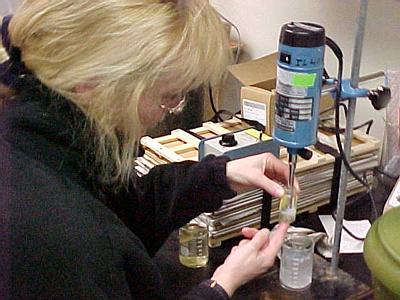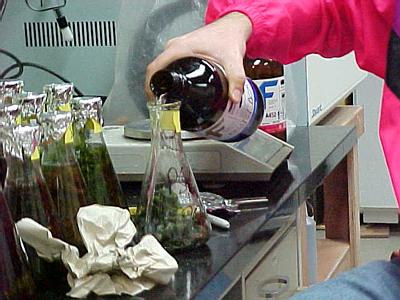21 March, 2000
Algae Extraction
Question 31: In what month is the smallest surface area of the Southern Ocean
covered by ice? In what month is there maximum ice coverage?
The weather is still overcast and above freezing today. There has been much
less wind than is normal at Palmer Station, good for us as we can go out
diving every day! If the wind goes above 20 knots there are no boating
operations. I dove off the north side of Christine Island with Drs. Amsler
and Baker today. The island edge is a wall that turns into a stair-like
alternation of walls and sloping ledges underwater. We went down to 110 feet,
then worked our way back up to the boat anchor. This site has lots of
invertebrates: sponges, nudibranchs, gastropods, starfish, sea cucumbers, and
tunicates (once we get underwater pictures, I will go into more detail on both
invertebrate and plant life).
When we returned to the station, I helped Dr. Katrin Iken and Bruce Furrow
set up some algae extractions. In all of the experiments our group is
running, we are focused on the chemicals used by the organisms. To get those
chemicals out where we can work with them we have to extract them. We use
chemical solvents to do this.
After we collected, sorted and recorded the amounts and species of
macroalgae, it went into numbered bags in the freezer (and freeze-dryer) to
keep its chemical structure in good shape. We start the extraction with that
frozen hunk of algae. Depending on the amount of water the fresh algae
contains, the frozen hunk may be easy or difficult to break into pieces. For
some of them we have to use a chisel and hammer, on others we can just pull
some off with our hands. We want to get a little over 100 g of each algae.
For invertebrates we need only about 25 g of sample. Gram for gram,
macroalgae do not have as much chemical compound as invertebrates do, so we
need a larger sample to get the same amount of compound.
Before any of the algae can go into the flask, we have to tare the empty
flask on the balance. Tareing means weighing the empty container you are
going to use so it can be subtracted from your final weight. That gives you
the weight of only the contents, the part you are interested in. Our
electric balance does the subtraction automatically. Once we weigh the
sample, it is recorded and then the solvent is poured in.
We are using a 50/50 mix of dichloromethane and methanol. It is a solvent
for chemical compounds that don't like water-- fatty or lipophilic compounds.
It forces the water to come out of the sample of macroalgae and the
lipophilic compounds to go into the solvent. The energy used up in the
process causes the flasks to feel very cold to the touch even though they are
sitting out at room temperature. The layer of water is taken off and more
solvent added two more times. After a little more processing, the extracted
chemicals from the solvent are ready to be worked with. This takes several
days.
For some experiments, such as the Folin-Denis assay that Dr. Iken and I are
working on, we can do a less complicated extraction. That involves only
grinding (also called homogenizing) a small sample of macroalgae in 20 ml of
methanol and letting the mixture soak for 24 hours.
Answer 30: Besides Leopard and Crabeater seals, there are Southern Elephant
seals, Weddell seals and Ross seals, all of which eat mainly fish and squid,
and Antarctic Fur seals, which eat krill.

Placing algae into tared flask.

Katrin Iken breaking apart a block of macroalgae.

Bruce Furrow weighing sample of algae.

Katrin Iken homogenizing macroalgae tissue.

Pouring solvent into flask.

Algae extracting in flasks full of solvent (division between solvent and water is visible on some).

Contact the TEA in the field at
.
If you cannot connect through your browser, copy the
TEA's e-mail address in the "To:" line of
your favorite e-mail package.
|
